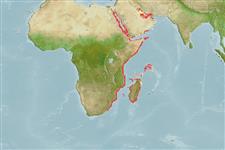Classification / Names
Common names from other countries
Main reference
Size / Weight / Age
Max length : 27.0 cm TL male/unsexed; (Ref. 50671); common length : 20.0 cm TL male/unsexed; (Ref. 30573)
Length at first maturity
Lm 13.7 range ? - ? cm
Environment
Marine; brackish; reef-associated; depth range 1 - 30 m (Ref. 50672)
Climate / Range
Subtropical, preferred ?; 32°N - 36°S, 25°E - 58°E
Distribution
Short description
Dorsal
spines
(total): 13;
Dorsal
soft rays
(total): 10;
Anal
spines: 7;
Anal
soft rays: 9;
Vertebrae: 23. Upper body gray, green or brownish, silvery below; iris iridescent silver or golden. Body color patterns extend to the fins. Spines slender, pungent and venomous. Preopercular angle 88°-96°; cheeks scaled; midline of thorax, isthmus and midline of belly without scales. Frightened fish become mottled or with 6 diagonal zones across side. Tip of broad-based flap of anterior nostril reaching at least halfway to orifice of posterior nostril.
IUCN Red List Status (Ref. 115185)
Human uses
Fisheries: minor commercial; aquaculture: commercial
More information
ReferencesAquacultureAquaculture profileStrainsGeneticsAllele frequenciesHeritabilityDiseasesProcessingMass conversion
Tools
Special reports
Download XML
Internet sources
Estimates of some properties based on models
Phylogenetic diversity index
PD50 = 0.5000 many relatives (e.g. carps) 0.5 - 2.0 few relatives (e.g. lungfishes)
Trophic Level
2.0 ±0.0 se; Based on diet studies.
Resilience
Medium, minimum population doubling time 1.4 - 4.4 years (K=0.22, tm=1-2)
Vulnerability
Low to moderate vulnerability (32 of 100)
Price category
